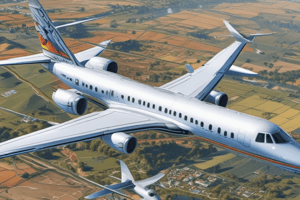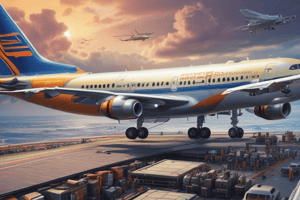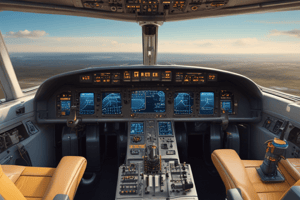Podcast
Questions and Answers
What is the maximum rate of stabilizer movement when a pitch trim switch is activated?
What is the maximum rate of stabilizer movement when a pitch trim switch is activated?
0.4 degrees per second
What conditions must be satisfied for the FCS to be in the Cruise sub-mode?
What conditions must be satisfied for the FCS to be in the Cruise sub-mode?
On-ground sub-mode logic not satisfied, AOA limiting sub-mode logic not satisfied, and Autopilot engaged OR both landing gear and flap handles up
How is pitch control designed at high altitudes?
How is pitch control designed at high altitudes?
Conventional with additional damping
What protection is provided if the aircraft exceeds the maximum operating speed?
What protection is provided if the aircraft exceeds the maximum operating speed?
Is there any protection against exceeding the maximum mach number?
Is there any protection against exceeding the maximum mach number?
Describe the backup pitch control mode and how it is activated.
Describe the backup pitch control mode and how it is activated.
What are the components that make up the pilot and copilot control wheel and column assemblies?
What are the components that make up the pilot and copilot control wheel and column assemblies?
What is the purpose of the pitch override mechanism?
What is the purpose of the pitch override mechanism?
Explain the concept of pitch authority limit and how it is implemented in the aircraft's pitch control system.
Explain the concept of pitch authority limit and how it is implemented in the aircraft's pitch control system.
Describe the purpose and operation of the pitch trim nose up and nose down limit switches.
Describe the purpose and operation of the pitch trim nose up and nose down limit switches.
Describe the operation of the yaw damper system between 60 KCAS and 90 KCAS.
Describe the operation of the yaw damper system between 60 KCAS and 90 KCAS.
What is the maximum rate of stabilizer movement commanded by the pitch trim system?
What is the maximum rate of stabilizer movement commanded by the pitch trim system?
Describe the conditions that must be met for the FCS to be in the Takeoff and Landing (TL) sub-mode.
Describe the conditions that must be met for the FCS to be in the Takeoff and Landing (TL) sub-mode.
How does the pitch control system behave at speeds of approximately 135 KCAS and below?
How does the pitch control system behave at speeds of approximately 135 KCAS and below?
Describe how the pitch control system's behavior changes as speed increases above approximately 135 KCAS.
Describe how the pitch control system's behavior changes as speed increases above approximately 135 KCAS.
What is the recommended approach speed in strong or gusty wind conditions?
What is the recommended approach speed in strong or gusty wind conditions?
How does the roll control system work during the landing/flare phase?
How does the roll control system work during the landing/flare phase?
What is the maximum deflection of the roll spoilers during landing/flare?
What is the maximum deflection of the roll spoilers during landing/flare?
What is the purpose of the yaw damper during landing/flare?
What is the purpose of the yaw damper during landing/flare?
What is the effect of 'nose up trim' input during landing/flare?
What is the effect of 'nose up trim' input during landing/flare?
Flashcards are hidden until you start studying



